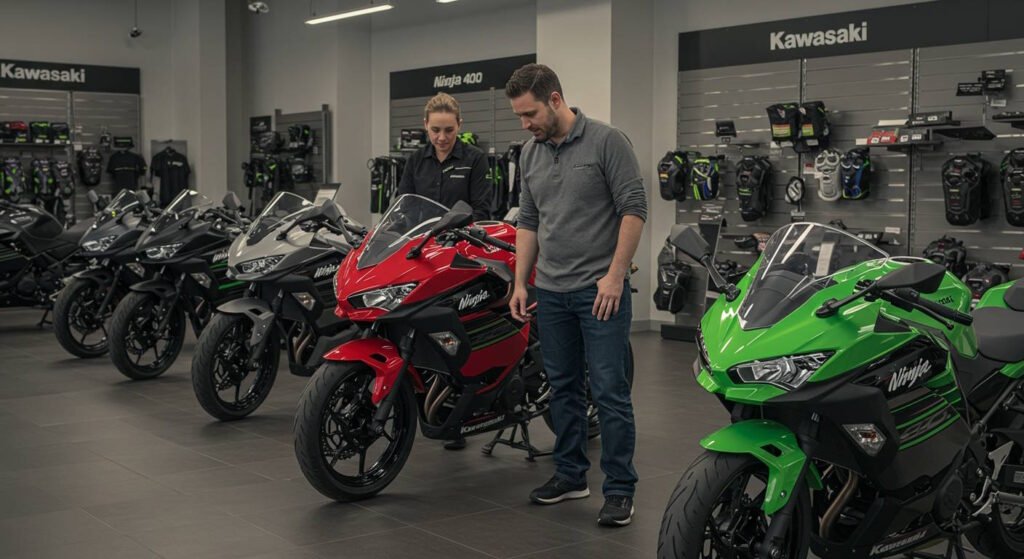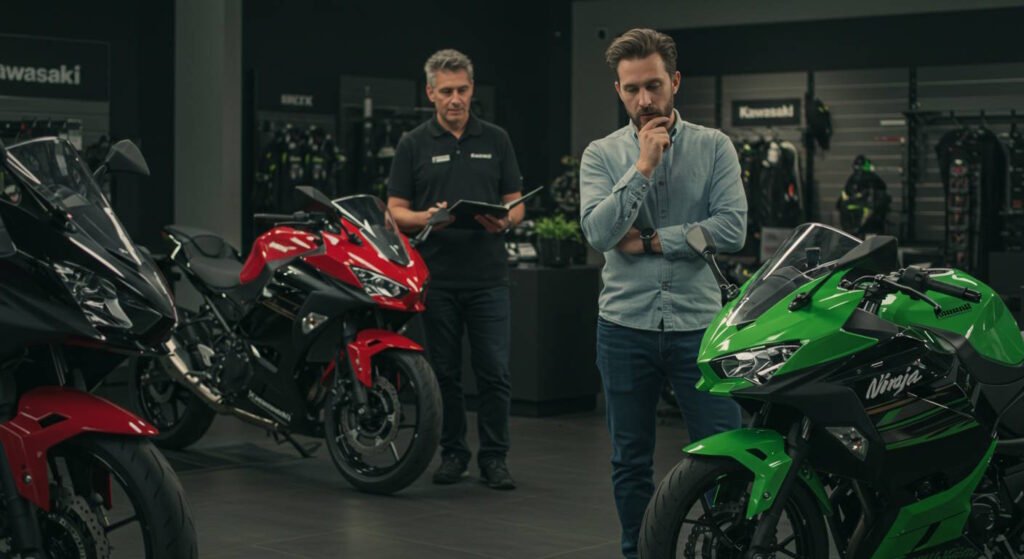The Kawasaki Ninja 400 is a 399 cc sport bike introduced by Kawasaki in 2018 as a successor to the Ninja 300. This upgrade addressed both the Ninja 300’s struggles with Euro 4 emission standards and market demands for more power in the entry-level segment. The well-timed evolution has made the Ninja 400 one of the most popular entry-level sport bikes in America, offering improved performance and handling that appeals to both beginners and experienced riders seeking a lightweight, nimble motorcycle.
Specifications And Purchasing Considerations
Engine Performance
- Engine Type: 399cc liquid-cooled parallel-twin
- Horsepower: 45-49 hp at 10,000 RPM
- Torque: 28 lb-ft at 8,000 RPM
- Top Speed: 115-120 mph
- Power Delivery: Smooth low-end (2,000-4,000 RPM), punchy mid-range (5,000-8,000 RPM), and eager top-end (8,000+ RPM)
- Cooling System: Liquid-cooled
- Displacement: 399 cc
Physical Dimensions
- Wet Weight: 361.6 to 366 pounds
- Seat Height: 30.9 inches
- Length: 78.3 inches
- Width: 28.0 inches
- Height: 44.1 inches
- Fuel Tank Capacity: 3.698 gallons
Passenger Capabilities
- Passenger Accommodation: Yes
- Features: Dedicated passenger seat, rear footpads, and grab handles
- Limitations: Limited comfort for longer trips (typical of sport bikes)
Engine Durability
- Expected Lifespan: 50,000+ miles with proper maintenance
- Maximum Reported Mileage: 80,000+ miles (with proper care)
- Cooling Efficiency: Excellent temperature management in hot weather and stop-and-go traffic. Here’s a complete blog on The Kawasaki Ninja 400 Top Speed and Performance.
Kawasaki Ninja 400 Colors Options
The 2025 Ninja 400 is available in several color schemes:
- Metallic Carbon Gray/Metallic Matte Carbon Gray
- Metallic Spark Black/Metallic Flat Spark kawasaki ninja 400 black
- Lime Green kawasaki ninja 400/Ebony (KRT Edition)
- Pearl Blizzard kawasaki ninja 400 white/Metallic Matte Fusion Silver
Color availability can affect pricing, with special editions commanding a slight premium.
MSRP vs Out-the-Door Price
The Manufacturer’s Suggested Retail Price (MSRP) for kawasaki ninja 400 price starts at around $5,199 for the non-ABS model and $5,699 for the ABS version. However, the actual out-the-door price typically runs $1,000-1,800 higher after factoring in dealer fees, documentation charges, freight, assembly, and taxes.
Pro tip: Dealerships often have more flexibility on pricing for previous model years or during the off-season (late fall through winter in many states).
Kawasaki Ninja 400 Warranty Coverage
You’ll get a 12-month limited warranty. This factory warranty covers defects in materials and workmanship but doesn’t include normal wear and tear.
Extended warranties are available through Kawasaki (Kawasaki Protection Plus) or third-party providers, typically extending coverage to 24, 36, or even 48 months. These can cover mechanical breakdowns beyond the factory warranty period, but read the fine print carefully, as not all components may be covered.
Dealer Fees to Expect
When you buy Kawasaki ninja 400, you’ll likely encounter several dealer fees:
- Destination/freight charge: $400-500
- Setup/assembly fee: $200-400
- Documentation fee: $100-300
- Title and registration: Varies by state
Some of these fees are negotiable, particularly setup and documentation fees. Don’t be afraid to ask the dealer to reduce or waive certain charges, especially if you’re paying in cash or financing through them.
Kawasaki Ninja 400 Insurance Costs
Insurance for the motorcycle is relatively affordable compared to larger sport bikes. For riders with clean records, full coverage typically ranges from $400-800 annually (most riders are paying around $300-$400 per year ($25-$33 per month) to insure their Ninja 400) depending on your age, location, riding history, and chosen deductibles.
Many insurance providers offer discounts for completing motorcycle safety courses, having multiple policies, or installing anti-theft devices.
Financing Options
Most dealerships offer financing through Kawasaki’s own financial services or partner banks. Typical terms range from 36-72 months, with interest rates varying based on your credit score.
Credit unions often provide more competitive rates than dealer financing, so it’s worth shopping around before walking into the showroom. Many riders save hundreds or even thousands in interest by securing pre-approval from their bank or credit union.
Standard Accessories
The Ninja 400 comes fairly well-equipped from the factory with LED headlights, a digital/analog combination instrument panel, and a rear seat cowl (on some models).
However, many dealers include additional accessories as incentives, such as frame sliders, tank pads, or even a first service. These can be valuable additions and are often worth negotiating for if not initially offered.

Ownership Costs
Insurance Rates in Detail
While we touched on insurance earlier, it’s worth noting that rates vary significantly based on several factors:
- Urban riders typically pay 30-50% more than rural riders
- Riders under 25 may pay double what riders over 40 pay
- Comprehensive and collision coverage adds significant cost but protects your investment
- Higher deductibles ($500-1,000) can reduce premiums by 15-30%
Replacement Parts
One advantage of the Ninja 400’s popularity is the wide availability and relatively reasonable cost of replacement parts. Some common replacement costs include:
- Clutch lever: $20-40
- Brake lever: $20-40
- Mirrors: $40-80 per side
- Fairings: $200-400 per panel (OEM)
- Windscreen: $70-150
Aftermarket parts can often be found for 40-60% less than OEM parts, though quality may vary.
Consumable Costs
Regular consumables for the Ninja 400 include:
- Tires: $250-350 per set (typically lasting 8,000-12,000 miles)
- Chain and sprockets: $150-300 (usually needing replacement every 15,000-25,000 miles)
- Oil and filter: $30-50 per change (recommended every 4,000-6,000 miles)
- Brake pads: $30-60 per set (front typically needing replacement more frequently than rear)
Kawasaki Ninja 400 For Sale: Resale Value
This bike holds its value remarkably well compared to many other motorcycles. After three years, a well-maintained Ninja 400 typically retains 70-75% of its original value. Even five-year-old models often sell for 60-65% of their original price.
This strong resale value makes the Ninja 400 a smart financial choice for riders who may want to upgrade after gaining experience.
Special Editions
The Ninja 400 KRT Edition (Kawasaki Racing Team) features special Kawasaki racing green livery inspired by Kawasaki’s Superbike World Championship team. Mechanically identical to the standard model, the KRT Edition commands a $200-300 premium for its distinctive graphics package. Kawasaki occasionally releases other special editions with unique color schemes or minor accessories, though mechanical specifications remain consistent.
Riding Gear & Accessories
Popular Aftermarket Parts
The massive popularity of the Ninja 400 has resulted in extensive aftermarket support. Common upgrades include:
- Slip-on exhausts from Akrapovič, Yoshimura, and Two Brothers Racing ($400-700)
- Fender eliminators for a cleaner tail section ($80-150)
- LED turn signals for improved visibility and aesthetics ($50-100)
- Adjustable levers for better ergonomics ($40-100)
- Frame sliders for crash protection ($100-200)
Crash Protection
Given that many Ninja 400 owners are newer riders, crash protection is a wise investment. Recommended options include:
- Frame sliders/crash bobbins from Shogun, T-Rex, or Woodcraft
- Axle sliders for additional protection
- Engine case covers to prevent expensive damage in a fall
- Handlebar guards for protecting levers in tip-overs
A complete crash protection package typically costs $200-400 but can save thousands in repairs.



